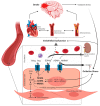Arginine Derivatives in Cerebrovascular Diseases: Mechanisms and Clinical Implications
- PMID: 32150996
- PMCID: PMC7084464
- DOI: 10.3390/ijms21051798
Arginine Derivatives in Cerebrovascular Diseases: Mechanisms and Clinical Implications
Abstract
The amino acid L-arginine serves as substrate for the nitric oxide synthase which is crucial in vascular function and disease. Derivatives of arginine, such as asymmetric (ADMA) and symmetric dimethylarginine (SDMA), are regarded as markers of endothelial dysfunction and have been implicated in vascular disorders. While there is a variety of studies consolidating ADMA as biomarker of cerebrovascular risk, morbidity and mortality, SDMA is currently emerging as an interesting metabolite with distinct characteristics in ischemic stroke. In contrast to dimethylarginines, homoarginine is inversely associated with adverse events and mortality in cerebrovascular diseases and might constitute a modifiable protective risk factor. This review aims to provide an overview of the current evidence for the pathophysiological role of arginine derivatives in cerebrovascular ischemic diseases. We discuss the complex mechanisms of arginine metabolism in health and disease and its potential clinical implications in diverse aspects of ischemic stroke.
Keywords: ADMA; ESUS; SDMA; arginine; atherosclerosis; atrial fibrillation; biomarker; endothelial dysfunction; homoarginine; stroke.
Conflict of interest statement
C.U.C. received a lecture fee from Pfizer. The other authors declare no conflict of interest.
Figures

Similar articles
-
Asymmetric dimethylarginine (ADMA), symmetric dimethylarginine (SDMA) and homoarginine (hArg): the ADMA, SDMA and hArg paradoxes.Cardiovasc Diabetol. 2018 Jan 4;17(1):1. doi: 10.1186/s12933-017-0656-x. Cardiovasc Diabetol. 2018. PMID: 29301528 Free PMC article.
-
Symmetric dimethylarginine predicts all-cause mortality following ischemic stroke.Atherosclerosis. 2010 Feb;208(2):518-23. doi: 10.1016/j.atherosclerosis.2009.06.039. Epub 2009 Jul 23. Atherosclerosis. 2010. PMID: 19700158
-
Plasma concentrations of arginine and asymmetric dimethylarginine do not reflect their intracellular concentrations in peripheral blood mononuclear cells.Metabolism. 2013 Oct;62(10):1455-61. doi: 10.1016/j.metabol.2013.05.017. Epub 2013 Jul 25. Metabolism. 2013. PMID: 23890667
-
Homoarginine in the shadow of asymmetric dimethylarginine: from nitric oxide to cardiovascular disease.Amino Acids. 2015 Sep;47(9):1741-50. doi: 10.1007/s00726-015-2017-y. Epub 2015 Jun 27. Amino Acids. 2015. PMID: 26123985 Review.
-
Association of asymmetric dimethylarginine and endothelial dysfunction.Clin Chem Lab Med. 2003 Nov;41(11):1467-72. doi: 10.1515/CCLM.2003.225. Clin Chem Lab Med. 2003. PMID: 14656027 Review.
Cited by
-
Molecular Probes, Chemosensors, and Nanosensors for Optical Detection of Biorelevant Molecules and Ions in Aqueous Media and Biofluids.Chem Rev. 2022 Feb 9;122(3):3459-3636. doi: 10.1021/acs.chemrev.1c00746. Epub 2022 Jan 7. Chem Rev. 2022. PMID: 34995461 Free PMC article. Review.
-
Plasma urea cycle metabolite levels and the risk of moyamoya disease.Front Neurosci. 2023 Jul 10;17:1163733. doi: 10.3389/fnins.2023.1163733. eCollection 2023. Front Neurosci. 2023. PMID: 37492403 Free PMC article.
-
The Role of the L-Arginine-Nitric Oxide Molecular Pathway in Autosomal Dominant Polycystic Kidney Disease.J Pers Med. 2024 Mar 11;14(3):299. doi: 10.3390/jpm14030299. J Pers Med. 2024. PMID: 38541041 Free PMC article.
-
Electrophoretic Determination of Symmetric and Asymmetric Dimethylarginine in Human Blood Plasma with Whole Capillary Sample Injection.Int J Mol Sci. 2021 Mar 15;22(6):2970. doi: 10.3390/ijms22062970. Int J Mol Sci. 2021. PMID: 33804011 Free PMC article.
-
Causal relationships of circulating amino acids with cardiovascular disease: a trans-ancestry Mendelian randomization analysis.J Transl Med. 2023 Oct 7;21(1):699. doi: 10.1186/s12967-023-04580-y. J Transl Med. 2023. PMID: 37805555 Free PMC article.
References
-
- GBD 2016 Lifetime Risk of Stroke Collaborators. Feigin V.L., Nguyen G., Cercy K., Johnson C.O., Alam T., Parmar P.G., Abajobir A.A., Abate K.H., Abd-Allah F., et al. Global, Regional, and Country-Specific Lifetime Risks of Stroke, 1990 and 2016. N. Engl. J. Med. 2018;379:2429–2437. doi: 10.1056/NEJMoa1804492. - DOI - PMC - PubMed
Publication types
MeSH terms
Substances
Grants and funding
LinkOut - more resources
Full Text Sources

